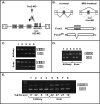Efficient in vivo manipulation of alternative pre-mRNA splicing events using antisense morpholinos in mice
- PMID: 21156798
- PMCID: PMC3057813
- DOI: 10.1074/jbc.M110.158154
Efficient in vivo manipulation of alternative pre-mRNA splicing events using antisense morpholinos in mice
Abstract
Mammalian pre-mRNA alternative splicing mechanisms are typically studied using artificial minigenes in cultured cells, conditions that may not accurately reflect the physiological context of either the pre-mRNA or the splicing machinery. Here, we describe a strategy to investigate splicing of normal endogenous full-length pre-mRNAs under physiological conditions in live mice. This approach employs antisense vivo-morpholinos (vMOs) to mask cis-regulatory sequences or to disrupt splicing factor expression, allowing functional evaluation of splicing regulation in vivo. We applied this strategy to gain mechanistic insight into alternative splicing events involving exons 2 and 16 (E2 and E16) that control the structure and function of cytoskeletal protein 4.1R. In several mouse tissues, inclusion of E16 was substantially inhibited by interfering with a splicing enhancer mechanism using a target protector morpholino that blocked Fox2-dependent splicing enhancers in intron 16 or a splice-blocking morpholino that disrupted Fox2 expression directly. For E2, alternative 3'-splice site choice is coordinated with upstream promoter use across a long 5'-intron such that E1A splices almost exclusively to the distal acceptor (E2dis). vMOs were used to test the in vivo relevance of a deep intron element previously proposed to determine use of E2dis via a two-step intrasplicing model. Two independent vMOs designed against this intronic regulatory element inhibited intrasplicing, robustly switching E1A splicing to the proximal acceptor (E2prox). This finding strongly supports the in vivo physiological relevance of intrasplicing. vMOs represent a powerful tool for alternative splicing studies in vivo and may facilitate exploration of alternative splicing networks in vivo.
Figures



References
Publication types
MeSH terms
Substances
Grants and funding
LinkOut - more resources
Full Text Sources

